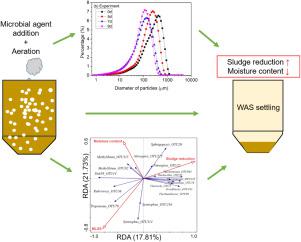Environmental Technology & Innovation ( IF 7.1 ) Pub Date : 2020-07-18 , DOI: 10.1016/j.eti.2020.101053 Bo Bian , Xiuren Hu , Limin Zhang , Xinxin Yan , Nan Shen

|
New methods to treat textile dyeing wasted sludge (TDWS) should be developed. In this study the sludge reduction induced by microbial agent addition and aeration in pilot-scale was studied. The one-off addition mode was employed in which better sludge reduction (i.e., 58.4%) and lower moisture content (i.e., 71.6%) were achieved. 25 L/min of aeration rate was best for sludge reduction and 52.8% of sludge reduction was achieved and aeration did play an important role in the sludge reduction. 15000 mg/L was determined as the suitable initial sludge concentration. The mechanisms of TDWS reduction were explored subsequently. As the results, the sludge particle size decreased with microbial agent addition while no such reduction was observed without microbial agent. The sludge would react with hydrolase to release organic substance and produce chemical oxygen demand (SCOD) in the liquid, which could be consumed by microorganisms. Finally, the change of microbial community was explored so as to further explain the mechanism of sludge reduction. The phylum Bacteroidetes increased from 33.30% to 45.37% with microbial agent addition which indicated the important role in sludge reduction. The genus Sphingopyxis, Thermomonas and Fluviicola would be the most relevant microorganisms with sludge reduction while the moisture content was most related with Dok59.
中文翻译:

通过微生物剂和曝气减少纺织污染中试污泥:参数优化和机理探索
应该开发处理纺织品染色废渣的新方法。在这项研究中,研究了中试规模的微生物添加和曝气引起的污泥减少。采用一次性添加模式,可实现更好的污泥减少率(即58.4%)和更低的水分含量(即71.6%)。25 L / min的曝气速率最有利于污泥的减少,污泥的减少率达到52.8%,并且曝气在污泥的减少中起着重要的作用。确定15000 mg / L为合适的初始污泥浓度。随后探讨了减少TDWS的机制。结果,污泥粒度随着添加微生物剂而减小,而没有微生物剂则没有观察到这种减小。污泥将与水解酶反应,释放出有机物质,并在液体中产生化学需氧量(SCOD),微生物可将其消耗掉。最后,探讨了微生物群落的变化,以进一步解释污泥减少的机理。门加入微生物剂后,拟杆菌的比例从33.30%增加到45.37%,这表明在减少污泥中起重要作用。Sphingopyxis,Thermomonas和Fluviicola属与污泥减少最相关的微生物,而水分含量与Dok59最为相关。



























 京公网安备 11010802027423号
京公网安备 11010802027423号